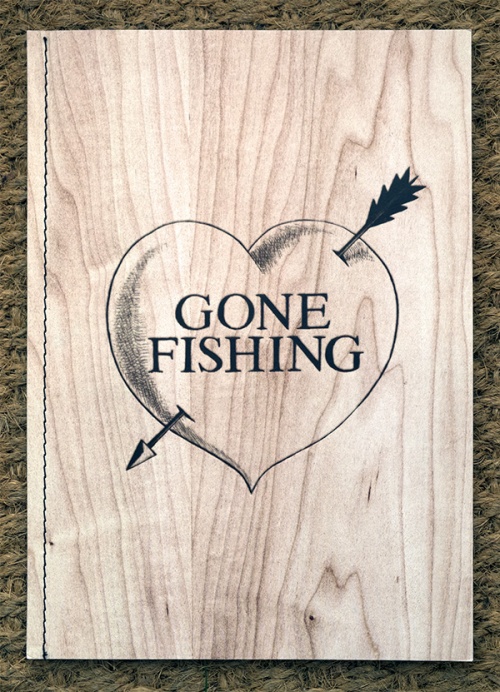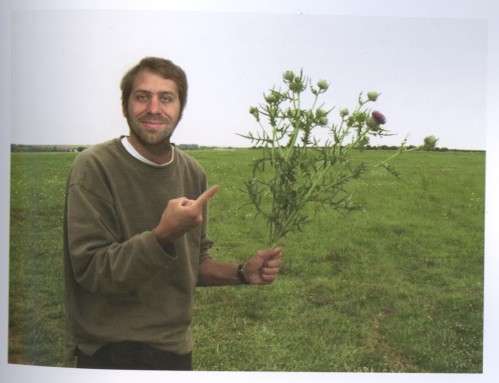Thomas Mailaender is one of my favorite photographers, although he is really better described as an artist. He has the ability to work on quite serious subjects in a humorous irreverent way. A fine example of this is his Gone Fishing project from 2010 that resulted in a book published in 2012. I didn’t review it at the time but a recent visit to Roman Road gallery, London, where the work is on show (until 15 April 2016), prompted me to buy a copy.

Thomas Mailaender’s book Gone Fishing. soft cover. A4. 39pp. Numbered edition of 500, 1-299 in French, 300-500 in English.
The work is fictional but is rooted in Mailaender’s own impending fatherhood at the time and, as with much good fiction, has the ring of truth, or at least credibility, about it. The work contains a series of letters and photos from Thomas to his long-suffering partner, the pregnant Marion. Thomas has decided that he cannot face the responsibility of being a father and has taken off on an long fishing trip to various parts of the world; a kind of extended stag party for the dad-to-be.
Each letter home is short and accompanied by a postcard-sized image of Thomas and his latest exploit but done with a subtle tongue-in-cheek humour. For example, alongside a picture of Thomas with a dead shark are the words
Sorry, but I needed to think about all this far from you and the baby. Soon I’ll be a father… It keeps turning around in my head and this little escapade is doing me a lot of good (I even caught a shark) and I think that now I feel ready for us to have a little girl together. I’ll be as promised in Paris Thursday evening.
A few letters later and he still hasn’t returned. He says
…I caught this superb 2.5kg sea bream. I can tell you I had to fight like a devil to get it. The poor beast struggled for over three quarters of an hour and the whole time I thought of you.
And in another letter
I found this superb thistle (in the photo). I spent a long time observing its most minute details: its striking vegetal beauty, the intense purple of its flower and the fine down that covers the slender stems almost make you forget the threatening needles at the end of the leaves. Don’t take it badly, but this plant reminds me of you.

Thistle image from Thomas Mailaender’s ‘Gone Fishing’. 2012.
The metaphor is obvious so it’s hardly surprising that he constantly complains he hasn’t had a reply from Marion! I bet she is purple – with rage.
The photographs all have a cheap snapshot aesthetic. Some of them look genuine while others have had Thomas’s face pasted in to what I assume is an image found on the Internet. This is all good – it adds to the humour and fiction of the work. Mailaender has taken the trouble to match the lighting on his face to the lighting of the found photograph so there is some skill behind the apparently artless snapshots.
The letters all have the theme of love for Marion and the intention of returning home very soon but expressed in such a way that the reader quickly gets the idea that there is a gulf between Thomas’s intent and the reality of his trip: he is enjoying himself way too much! This echos the conflict that many feel between the part of us that remains a child and the internal voice of the responsible adult that comes to dominate as we grow up. But the book doesn’t resolve this in Thomas’s case: we are left on a cliff-hanger as he wins a large sum of money which allows him to continue his escapist vacation. We wonder, will he be an absent father forever?
The exhibition and the book have the same content but the exhibition presents each letter alongside its accompanying photograph whereas in the book the letters and photos are printed single-sided, making them less of a pair. The letters are printed on a lighter weight paper and given the appearance of having been folded for the post. The photos are on a paper of similar weight to a high street photo processing machine with a gloss varnish over the image to enhance this impression. Printing the letters and images on separate sheets means that they cannot be viewed as a pair, which is an aspect of the exhibition that I liked. But this is a minor criticism and the book is still an entertaining, humorous and thought-provoking read.
